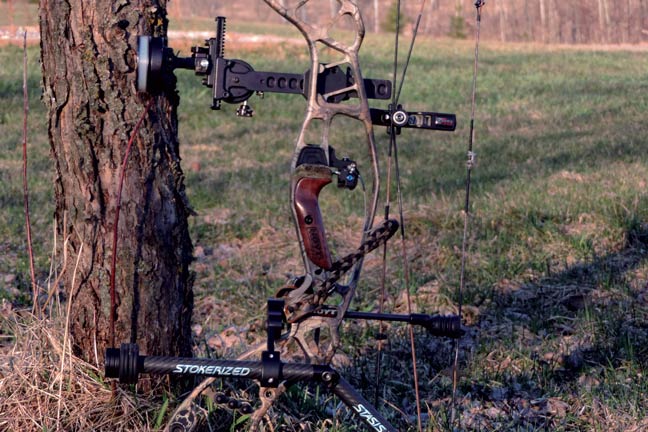Optimizing Your Archery Performance With the Right Compound Bow Stabilizer: a Detailed Overview
In the realm of uniformity, archery and precision are critical to attaining optimal efficiency. One often-overlooked yet vital component in enhancing accuracy is the compound bow stabilizer. This plain tool plays a significant function in steadying your aim, minimizing bow torque, and soaking up vibrations. The efficiency of a stabilizer pivots on different variables, consisting of placement, weight, and design. By recognizing the nuances of selecting and enhancing a compound bow stabilizer, archers can adjust their tools to elevate their capturing experience to new degrees of effectiveness and control.
Significance of Bow Stabilizers in Archery

Furthermore, bow stabilizers help in balancing the weight distribution of the bow, which can improve the archer's stability while shooting and intending. By adding weight to the front of the bow, stabilizers can lower the amount of torque experienced upon launch, causing a smoother and extra controlled shot - compound bow stabilizer. This weight circulation additionally helps in holding the bow constant for a longer duration, permitting the archer to aim more precisely
Sorts Of Substance Bow Stabilizers
When taking into consideration the various kinds of compound bow stabilizers offered, it is essential to recognize their distinct functions and features to determine the most appropriate option for taking full advantage of archery performance. The most usual types of substance bow stabilizers consist of sidebar stabilizers, front stabilizers, and back stabilizers. Back stabilizers, additionally called rear stabilizers, are installed to the back of the bow and aid in counteracting the weight of other devices, resulting in enhanced security and stable intending.
Factors to Think About When Choosing
In assessing compound bow stabilizers, recognizing the unique functions and features of each type is important for making a notified decision on the most ideal choice to boost archery performance. When selecting a stabilizer, one have to think about the weight of the stabilizer itself. While a heavier stabilizer can supply more security by reducing the bow's movement, it might likewise trigger tiredness during long shooting sessions. Balance is one more crucial element to ponder. The stabilizer's length and layout substantially affect the bow's equilibrium, influencing the shooter's capability to hold constant purpose. Additionally, the material of the stabilizer can influence its effectiveness. Carbon fiber stabilizers are light-weight and soak up resonances well, enhancing accuracy. The number and adjustability of dampeners on the stabilizer can tweak its efficiency by decreasing sound and shock upon launch. By very carefully reviewing these aspects, archers can choose a substance bow stabilizer that aligns with their shooting style and optimizes their general performance on the archery variety.
Installment and Adjustment Tips
For optimal performance and accuracy in archery, grasping the installation and modification of your bow stabilizer is necessary. Proper setup begins with connecting the stabilizer to the bow's riser, ensuring it is firmly protected.
When changing the stabilizer, start with little step-by-step modifications as opposed to extreme adjustments. This permits you to examine the impact of each alteration precisely. Pay focus to exactly how the bow responds to modifications in stabilizer settings and make changes as necessary. Bear in mind that the goal is to locate a setup that reduces hand torque, reduces vibration, and boosts precision. On a regular basis check the stabilizer's rigidity and total problem to guarantee it continues to operate efficiently. By understanding the installment and modification procedure, you can optimize your archery efficiency and elevate your capturing experience.
Upkeep and Treatment Standards

It is likewise vital to save your bow with the stabilizer in a risk-free and protected area when not in use. Adhering to these maintenance and treatment standards will aid you get the most out of your bow stabilizer and enhance your overall archery efficiency.
Final Thought
To conclude, choosing the right compound bow stabilizer is crucial for taking full advantage of archery efficiency. Recognizing the value, kinds, elements to think about, setup and adjustment ideas, along with upkeep and treatment guidelines can greatly impact one's precision and uniformity in shooting. By selecting a stabilizer that matches specific demands and choices, archers can improve their general efficiency and achieve much better results on the array or in competition.
Bow stabilizers play an essential role in enhancing an archer's precision and consistency by minimizing vibrations and stabilizing the bow throughout the launch of an arrowhead - compound bow stabilizer.Additionally, bow stabilizers Related Site help in stabilizing the weight circulation of the bow, which can enhance the archer's stability Website while shooting and intending. The most typical types of compound bow stabilizers include sidebar stabilizers, front stabilizers, and back stabilizers. Back stabilizers, also called rear stabilizers, are placed to the back of the bow and assist in reversing the weight of other devices, resulting in enhanced security and steady intending. When picking a stabilizer, one need to think about the weight of the stabilizer itself